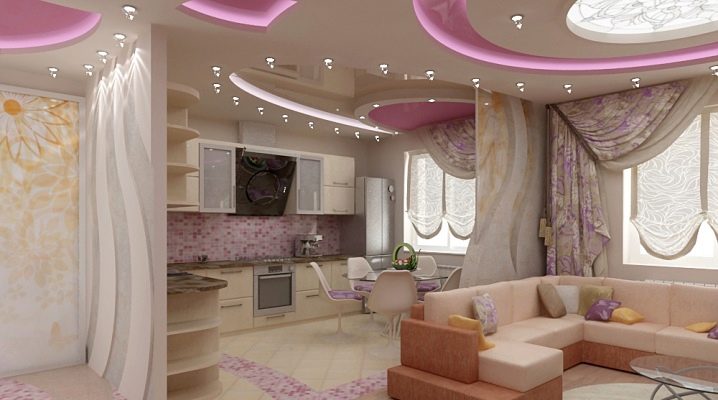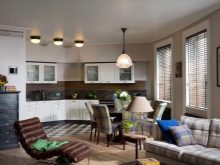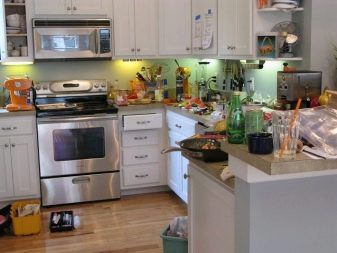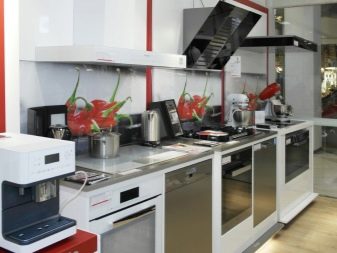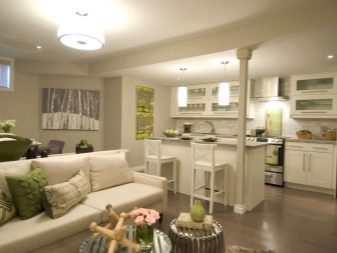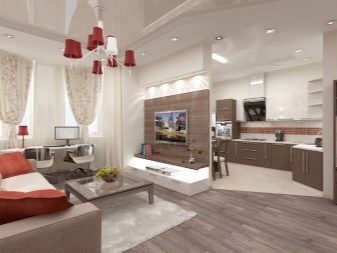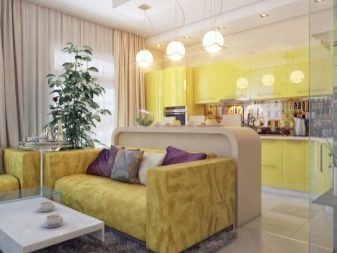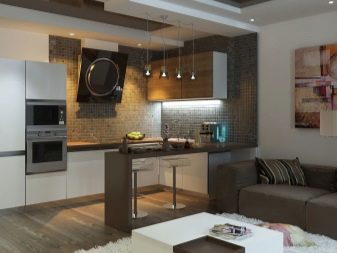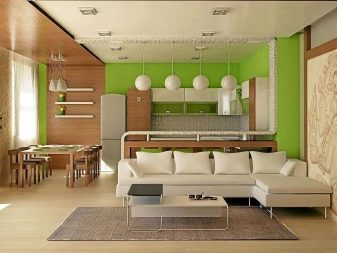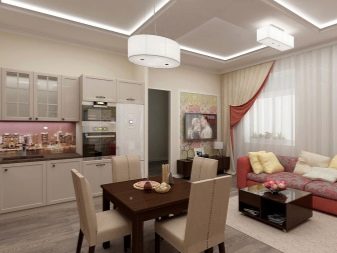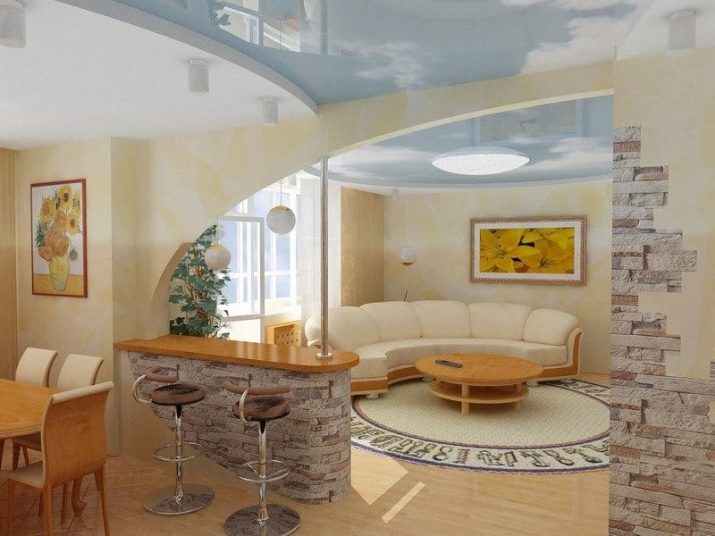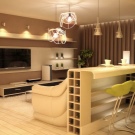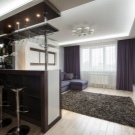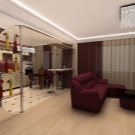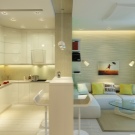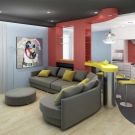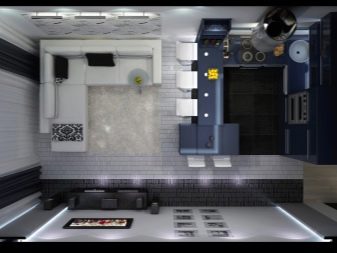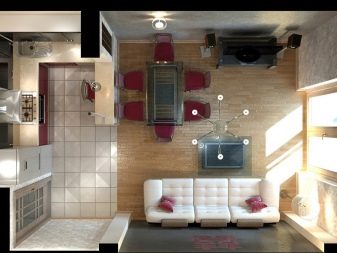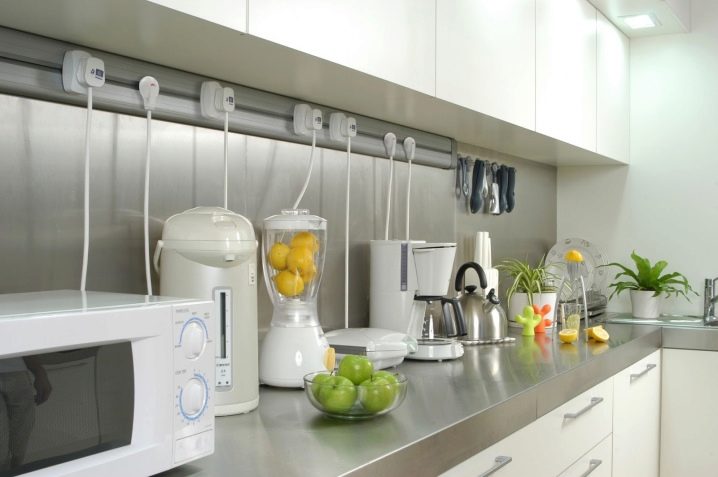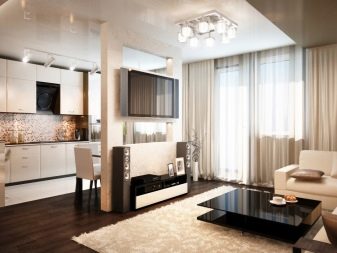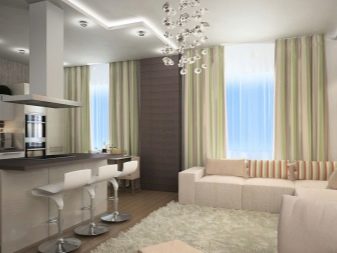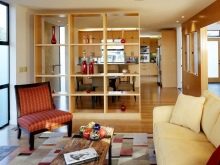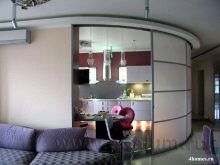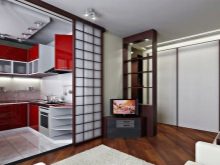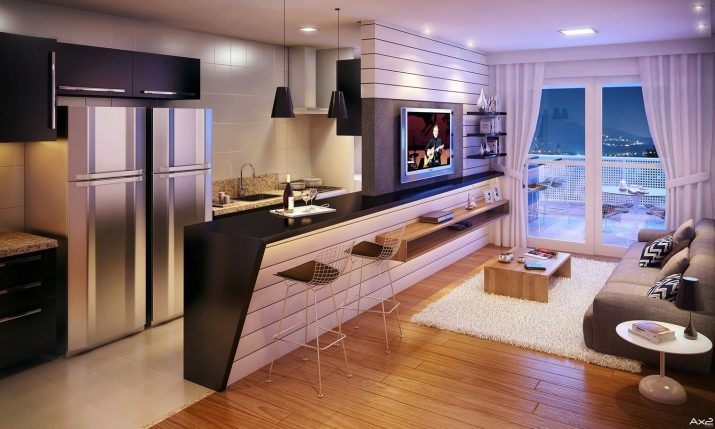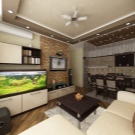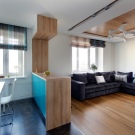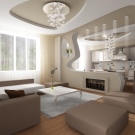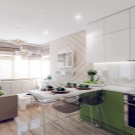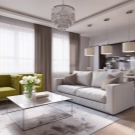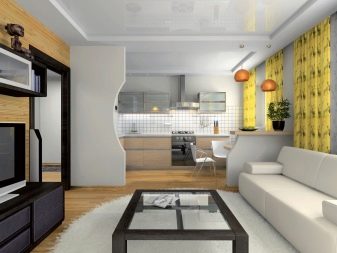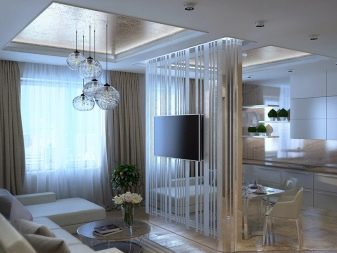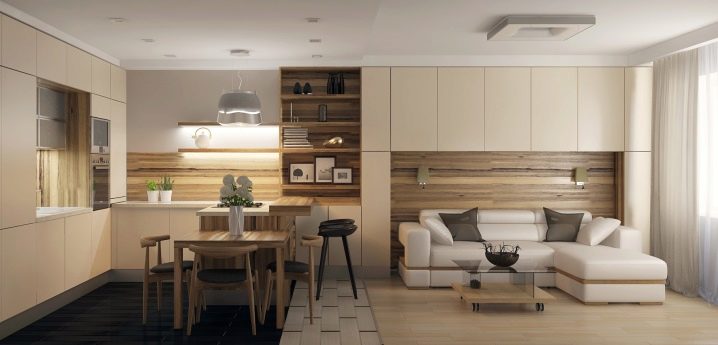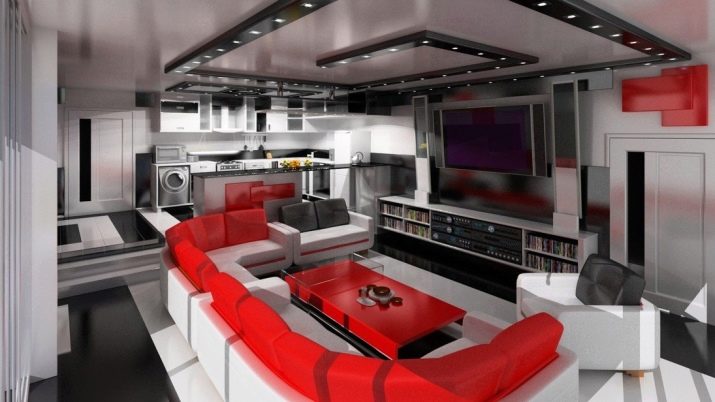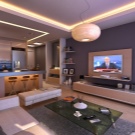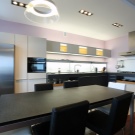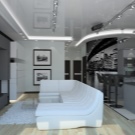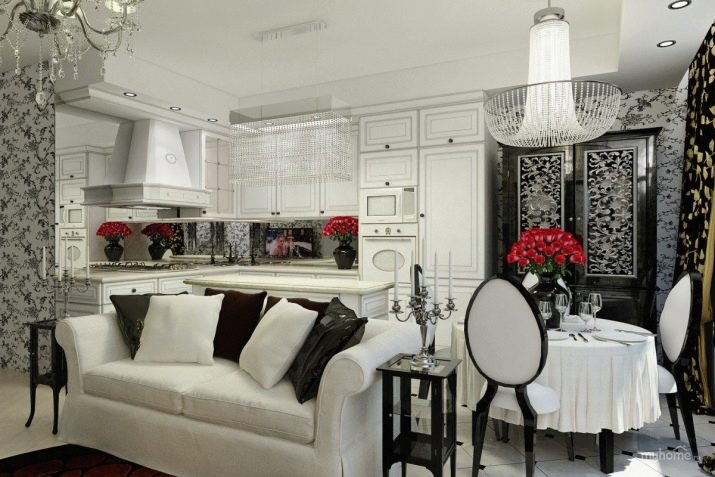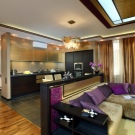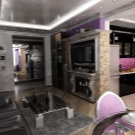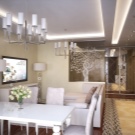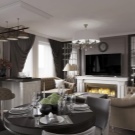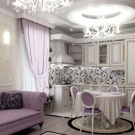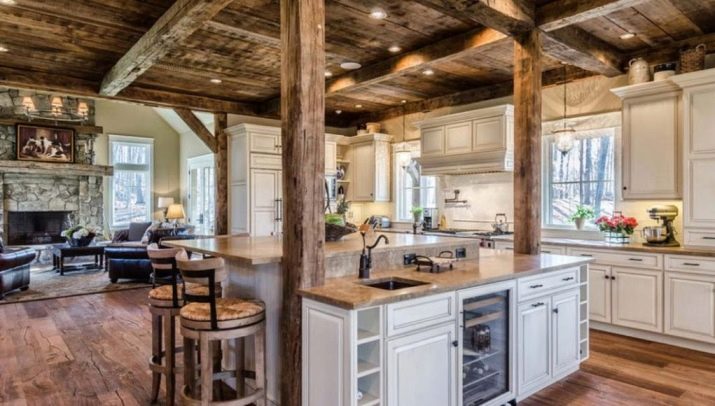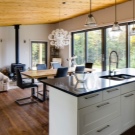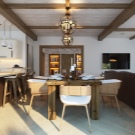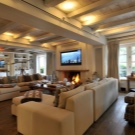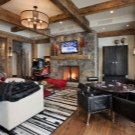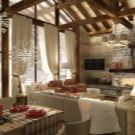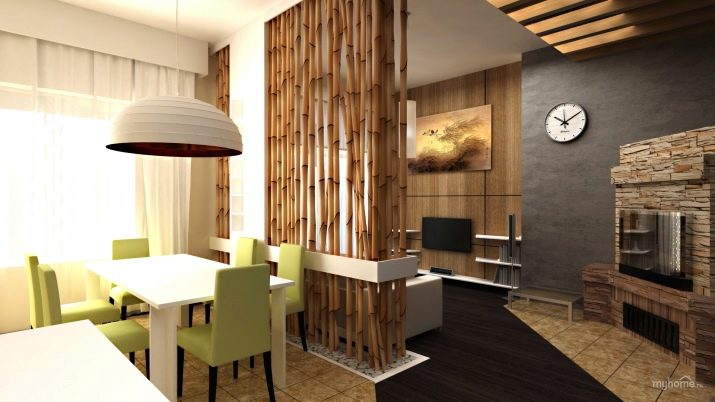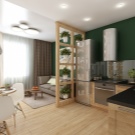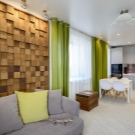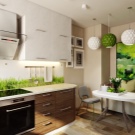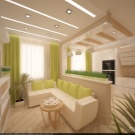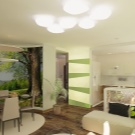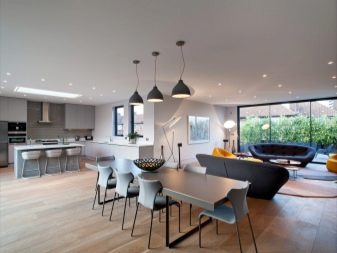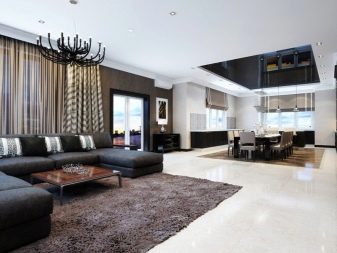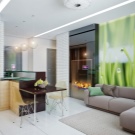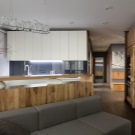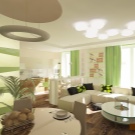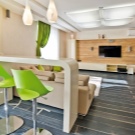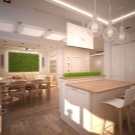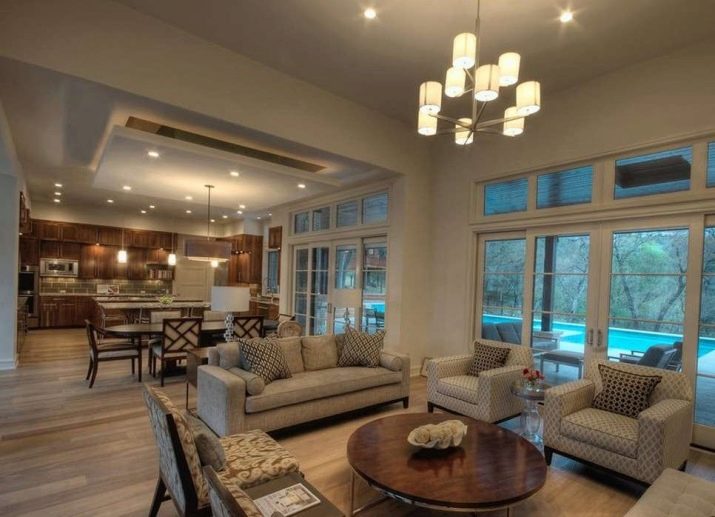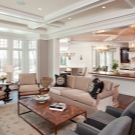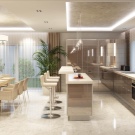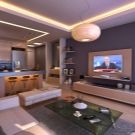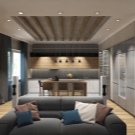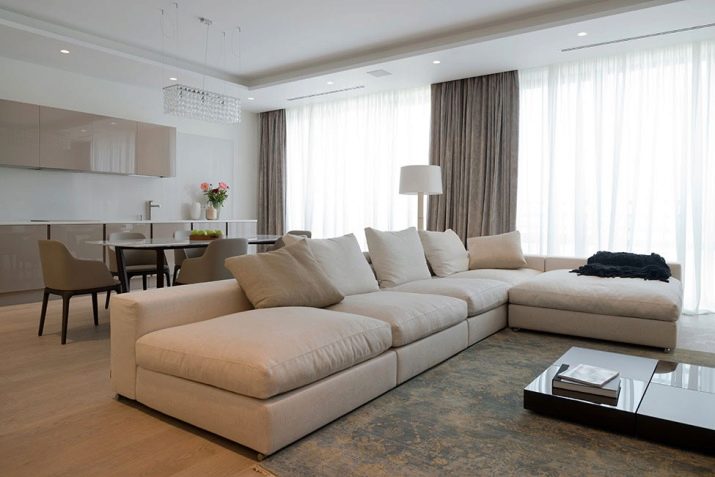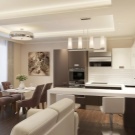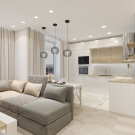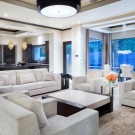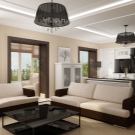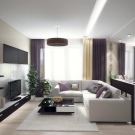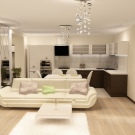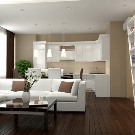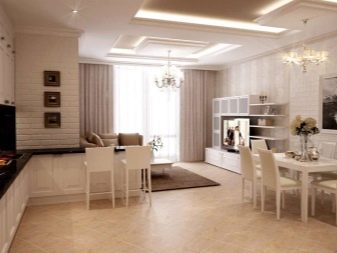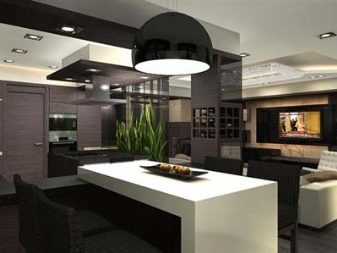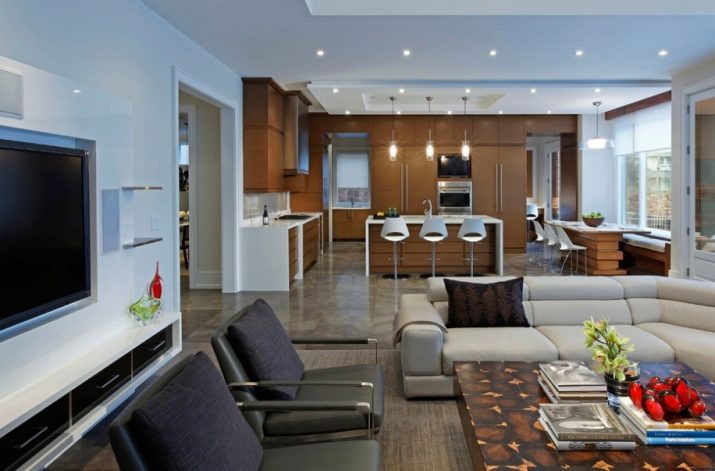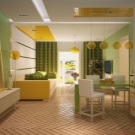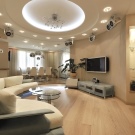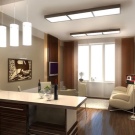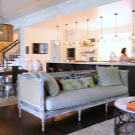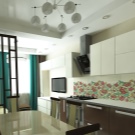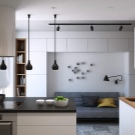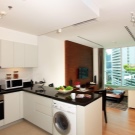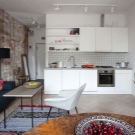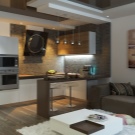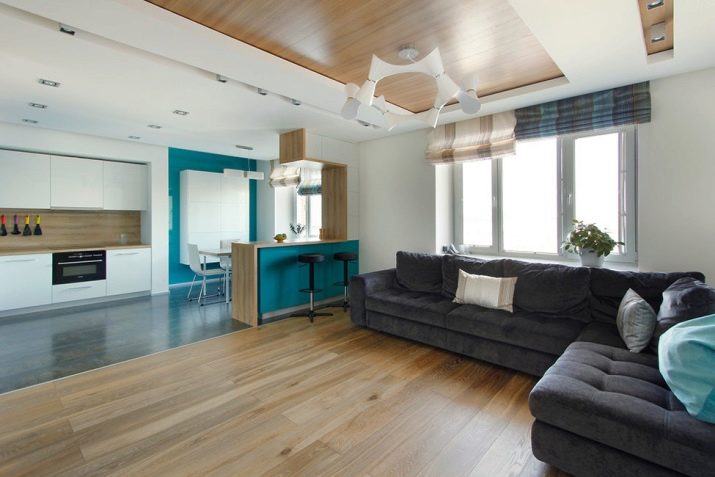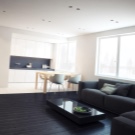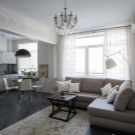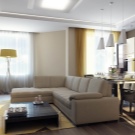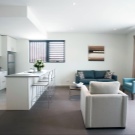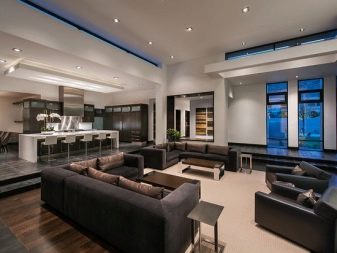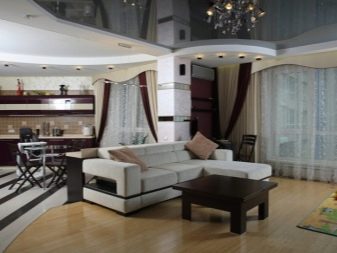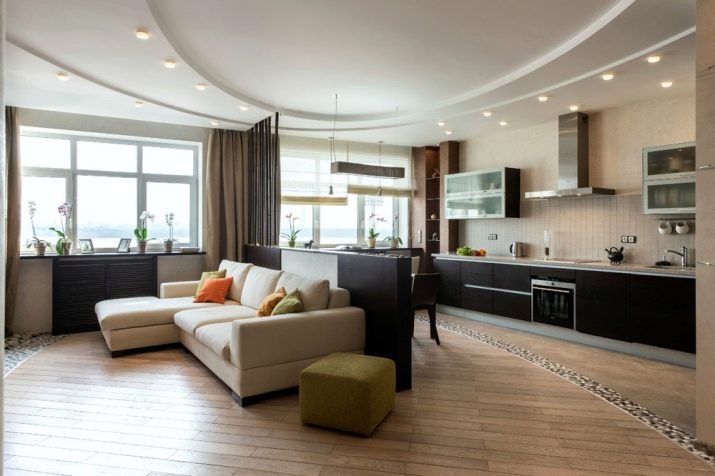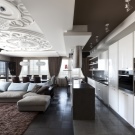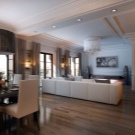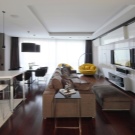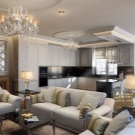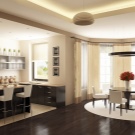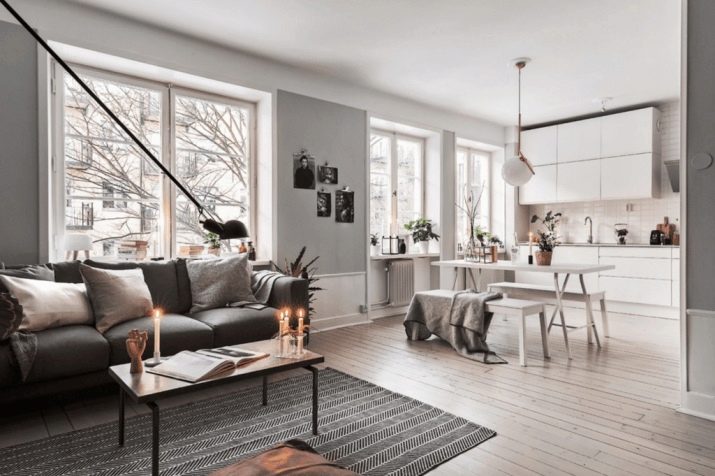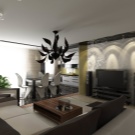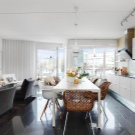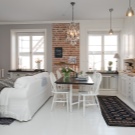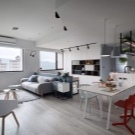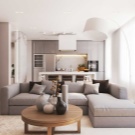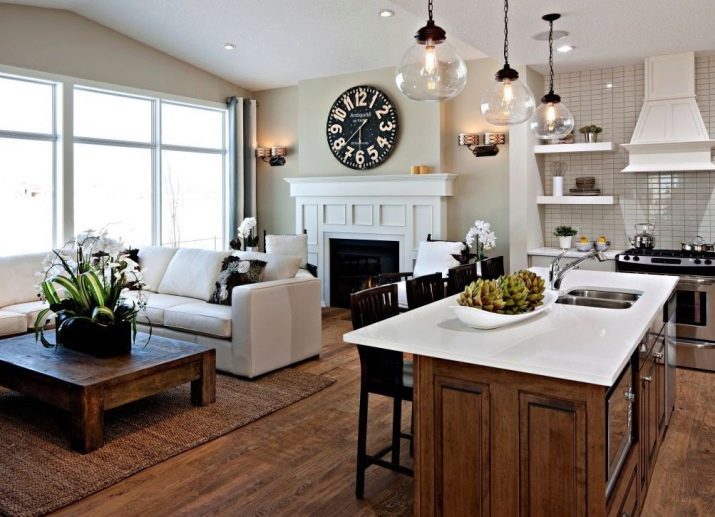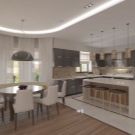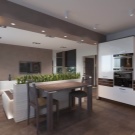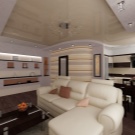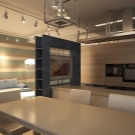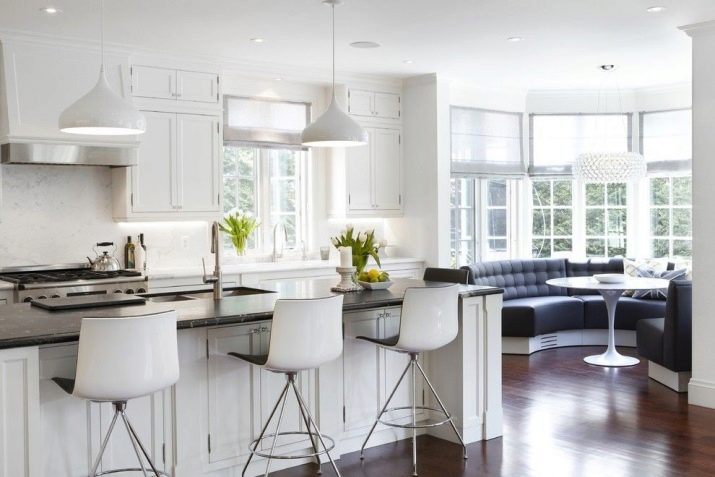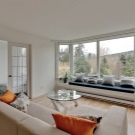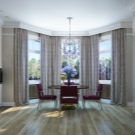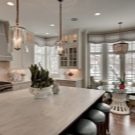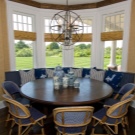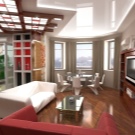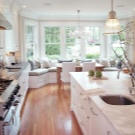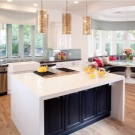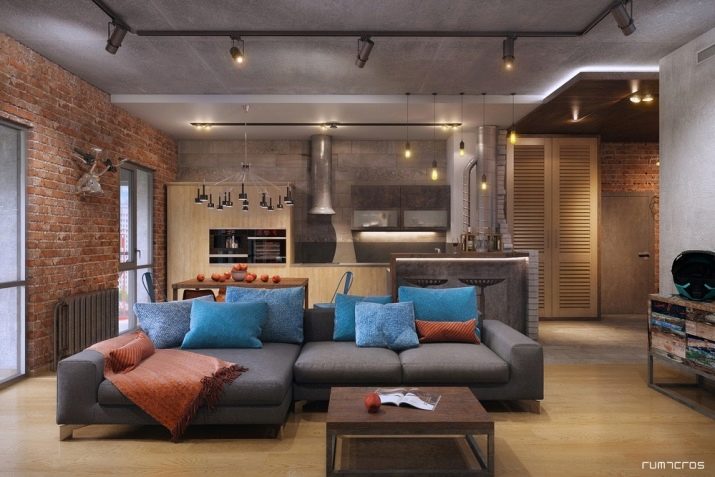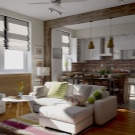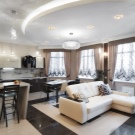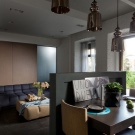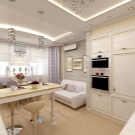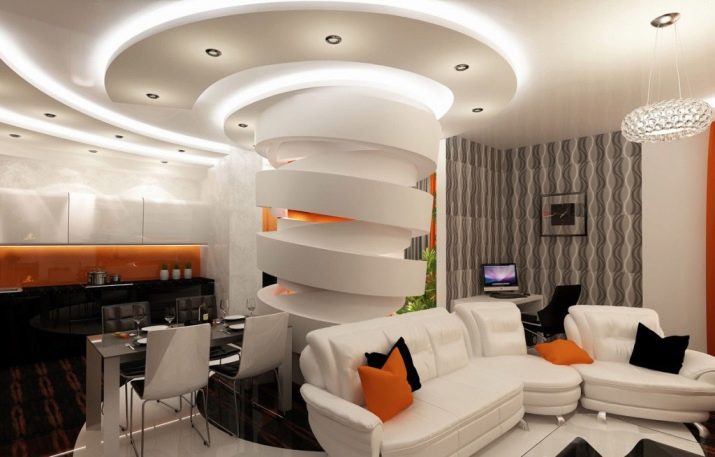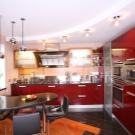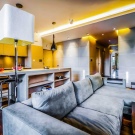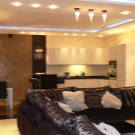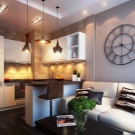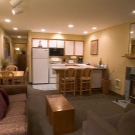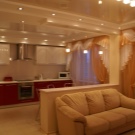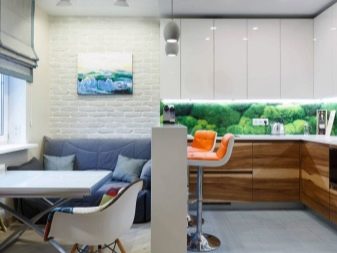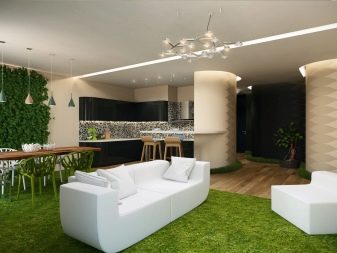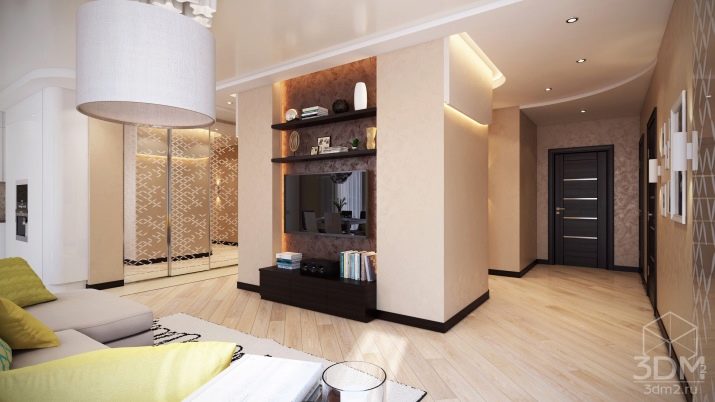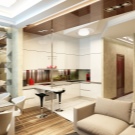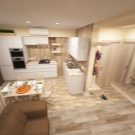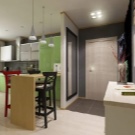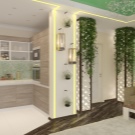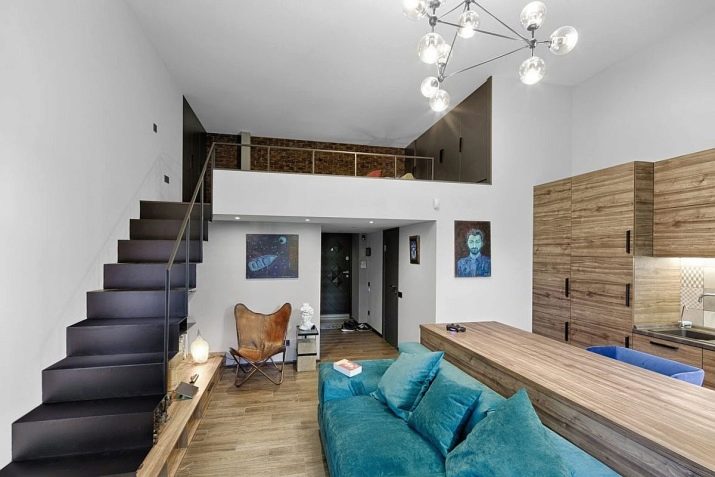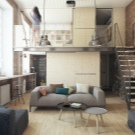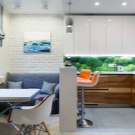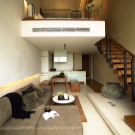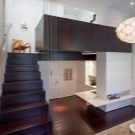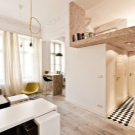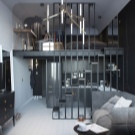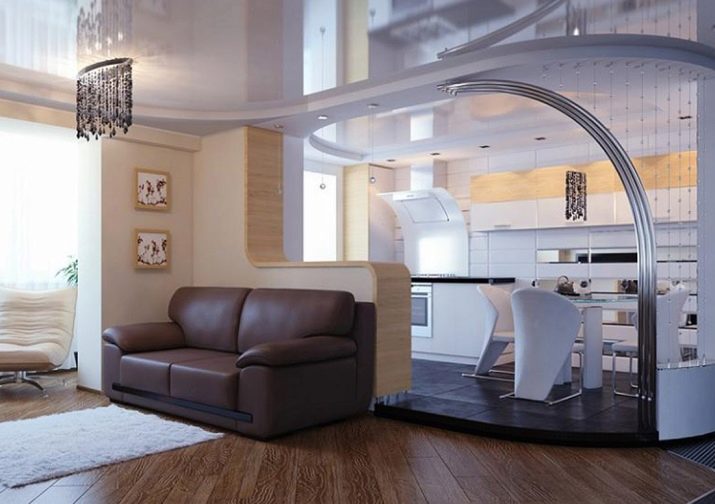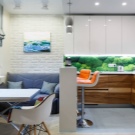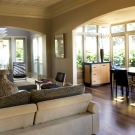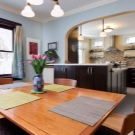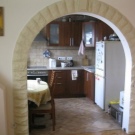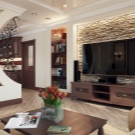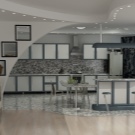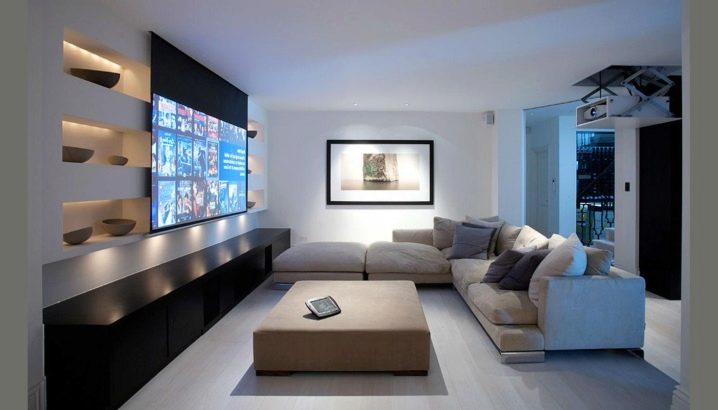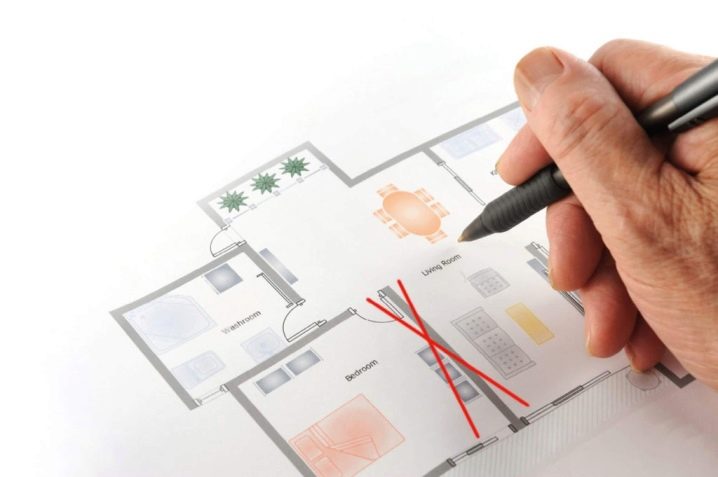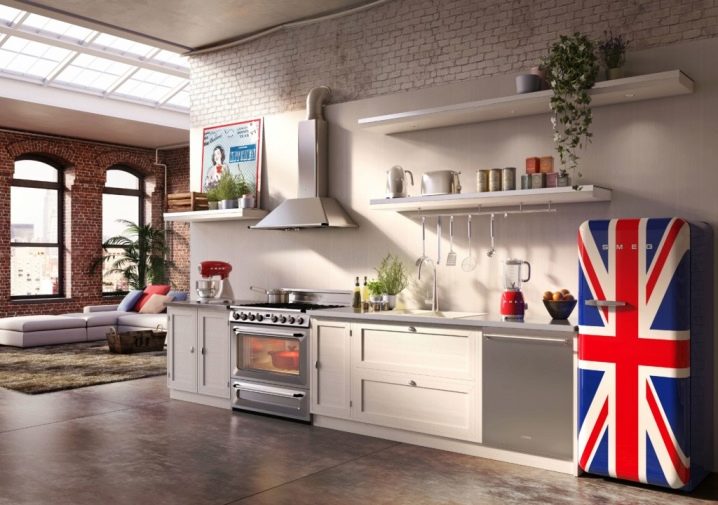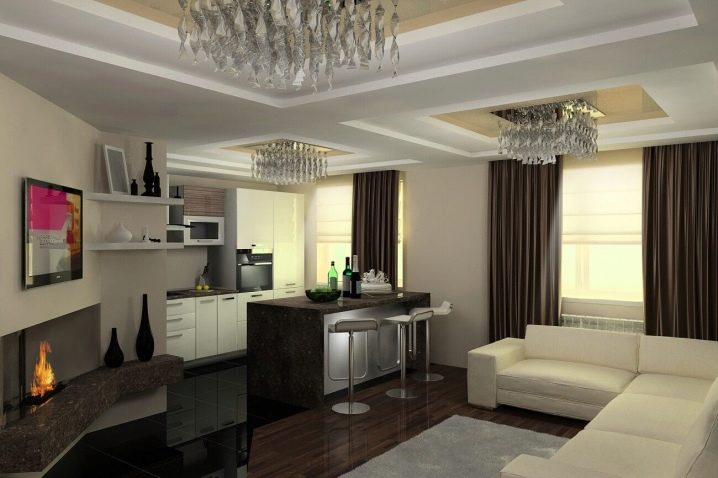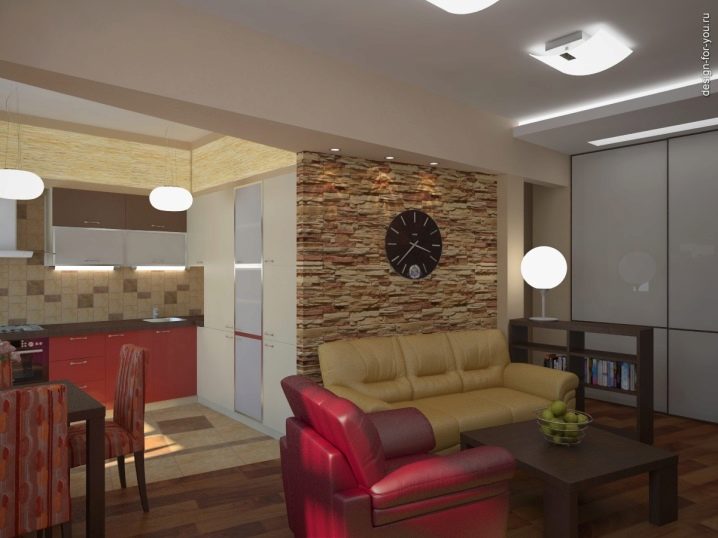Kitchen-living room design: important nuances and real examples
Combined kitchen-living room in a normal apartment today is not uncommon. There are a number of reasons why the owners prefer to combine the kitchen and dining area with a hall. However, in the combined part of the housing will be quite a lot of diverse areas, because the design must be very thoughtful, so that everything looks holistic, but does not merge.
Pros and cons of combining
If you have these rooms still separate, but the idea of combining them has long been ripening, you should think about whether it is practical at all to make such a decision or not. Do not rely only on what is now so fashionable - there are other advantages of such a union:
- in cramped apartments, the absence of an extra partition allows freeing up additional space;
- interaction between those present in the apartment increases - the hostess can simultaneously prepare and look after children or communicate with guests;
- instead of the typical two TVs, one is now enough, which can be watched from almost every corner of an apartment or cottage.
True, there are some disadvantages to which you should be ready:
- culinary smells, including unpleasant ones, will become regular guests in the hall;
- the kitchen in the process of cooking can get an ugly look, in the case of association with the living room, this shadow will also fall on the latter;
- the opportunity to retire and hide from the noise decreases, and if the whole kitchen equipment works at once, then the same TV from the kitchen can be not heard.
Select functional zones
The fact that there are no walls between the rooms does not mean that they should not be separated at all, otherwise there will be a complete mess in the apartment. Another thing is that the separator may not be an obstacle at all, being just a different finish of the floor and walls, or have additional functions, being a bar or a closet. It is also acceptable to separate by a small difference in the level of the floor or ceiling.Theoretically, the hall can also be included in the structure of the new room, but it is advisable not to remove all obstacles between the kitchen area and the place where the household sleeps, so that smells do not interfere with rest.
The combined space is traditionally divided into two or three main zones, although in the presence of space and imagination this can not be limited to. Quite typical components are the following:
- a kitchen in the classical sense of the word is a place where people are directly involved in cooking, everything must be present, including appliances, utensils and a work area;
- a living room, which in this variant of the interior almost surely assumes the functions of a dining area, and therefore a table with chairs is one of the key elements of its furnishings;
- Recreation area - rather, a bonus in the form of a coffee table and a sofa or armchair, which will be used on a daily basis by the owners themselves.
However, zoning is not always so categorical. For example, a narrow bar counter, installed between the kitchen and the living room, serves as a frequent zone divider - it looks stylish and is relatively inexpensive, and, importantly, can be used instead of a table.If the last statement is true, it turns out that the dining area no longer fully belongs to the living room itself - with an abundance of guests, they can be seated both in the living room and in the kitchen, while at the same time sitting at one common table.
We make a design project
The general idea of what should be the kitchen, combined with the living room, should not be a signal to start any work. The fact is that in the process of repair almost always unforeseen circumstances arise, which were ignored completely in vain - in the end it often turns out that to complete the project either does not work at all, or it strongly does not correspond to the plan.
Theoretically, a design project can even be compiled independently if you have the desire and at least some skills.However, it is better to trust a professional in this matter. For the majority of ordinary people, such a project is a common markup of communications, which, naturally, should not be forgotten either, but still the design should be given attention, otherwise the good half of the apartment will be spoiled. For this reason, it is necessary to draw everything in the smallest detail and with strict adherence to proportions - you should not just imagine, but just see,how best to arrange the furniture and how well it will be in harmony with the vending technique and window textiles.
At the same time, the pursuit of a stylish and unusual design should not interfere with the functionality, which is very relevant in the kitchen part of the combined room. For example, the same furniture should not interfere with access to sockets or valves, otherwise the elementary breakdown of such a small and inexpensive thing can turn into a complete repair of the whole kitchen-living room. When drafting a project, be sure to pay attention to the fact that all the equipment has access to the sockets, and the one that is connected to water can be connected to the water supply and sewage system - without this, even a smart arrangement of layout does not make any sense.
Zoning options
Although we combine the kitchen with the living room, in the human subconscious it usually still remains the idea that for each occupation in the dwelling there must be a separate zone. They do not need to be separated by whole walls, opening up large spaces, however, it is necessary to select at least the same kitchen, which is relatively dirty and has a completely different, specific finish.
Consider several popular solutions, in addition to the already mentioned difference in the decoration of walls and floor.
- Partitions, although not in the form of a wall, are used regularly. The bar counter, which has been very popular lately, has already been said - at its very low cost, it assumes rather wide functionality, without closing the review, but clearly sharing space. A similar solution is a two-sided cabinet - it has no partition, because its contents can be reached from any side. Finally, the ever-relevant solution is the sofa, which is simply unfolded back to the kitchen part - then it represents a small wall, as it were, without closing the view completely.
- Actually, the union of two spaces does not mean that there should absolutely not be a wall between them - it can be left, it will just be somewhat smaller, and then the passage can no longer be called a door or an arch. Such a wall usually has a purely symbolic meaning, occupies only a small part of the possible passage, and is usually specially made of drywall - it is given an unusual, beautiful shape, making it another decoration of the interior.
- The design of the floor or ceiling can also be a separator - it means not even the difference in materials, but the figured component. In the first case, one of the zones is like a podium, elevated in relation to the rest of the combined room, but in a situation with a ceiling, it is simply made multi-level, where over each zone is its own ceiling height.
We consider proportions
A kitchen connected to the living room is often called upon to solve the layout flaws - not only to increase the space, at least visually, but in some cases to correct the unfortunate form of each of the rooms. However, the pursuit of fashionable unification of space can lead to the fact that just such a repair will lead to the “deformation” of the room. However, it is design that often helps to correct such a flaw.
In particular, it is good if the kitchen was originally large (for example, 4 x 6 m) and the union was not made to expand it, but if the kitchen part seems to be a closet, it makes sense to “enlarge” it a little. For such purposes, light-colored trimming is used, which is not perceived by the subconscious as a sharp obstacle.In other rooms, mirrors could be used, which are not very appropriate in the kitchen, but here you can achieve a similar effect by using glossy materials, furniture or appliances that reflect light well. Playing with the color scheme is also worth it if the two parts (the kitchen and the living room) are somehow too disproportionate.
Too narrow room resembles a corridor, which also does not look very comfortable. In order to “lengthen” a short wall, in its decoration elements are used that are substantially elongated horizontally, and “corridor” walls, on the contrary, are hammered with vertically elongated elements. The latter method, by the way, is also very appropriate if the ceiling is too low. With the help of such small tricks, any room of an unsuccessful configuration - small, narrow, square - approaches the ideal in the presentation of its owner.
Please note that the individual parts of the kitchen-living room should not differ in size several times. The living room will almost certainly be a little more spacious, but the kitchen should not look like a closet in it - if the first is larger than the second, then this is already a problem.This moment can also be corrected by decorating methods, not only “enlarging” the kitchen, but also “reducing” the living room, if appropriate.
Style selection
The stylistic potential of the kitchen is perceived by many people as rather limited - the average person sees it as a predominantly utility room with an abundance of equipment, because high-tech seems almost the only appropriate solution for the majority of our fellow citizens. With this, of course, professional designers who see much more options will not agree, and they also have to combine the kitchen with the living room in common walls. In fact, fantasy may not be limited to anything at all, but it is worth highlighting the three styles that are seemingly popular, but so far completely unexplored.
- Art Deco charm The fact is that small decorative details play absolutely no secondary role here - they are turned into real art. In all other respects, the kitchen-living room can be ordinary, but there should be a lot of details, and they must be impressive, so the refined chandelier and light inlay on the table will be very appropriate.
- Chalet could be called a rustic style, but with a certain reservation - not in our understanding, but in Swiss. A room in this style suggests features that may not be homemade, but should at least imitate any. Most often, the desired effect is achieved due to the abundant use of wood (or outwardly very similar materials), which also should look cute and coarse.
- Eco style - This is a desperate desire for nature. Here, wooden elements will also come in handy, although you should not abuse them, for what care for nature, if it is all cut down. On the other hand, fresh flowers fit into this style very well. They can be decorated in a whole growth cabinet, which is the partition between the kitchen and the living room. The use of modern materials in our time can not be avoided, but for eco style, they are usually chosen characteristic range - white, green and shades of wood brown.
Color solutions
The trick to the kitchen-living room design is that it is necessary to highlight certain boundaries between the individual zones without breaking the room — otherwise, why bother to unite it at all.
For harmony and unity, listen to a few simple tips.
- Zones are almost always performed in different colors, but the selected colors should be well combined with each other, without provoking contradictions. The simplest solution would be to use two similar shades of the same color, but in general, the difference may even be in the details - for example, in the form or texture of the finish, slightly different patterns, and so on.
- In a large room, a bright accent is required, and not even one, but it is undesirable to allocate too large interior items such as a wardrobe or curtains. Due to the fact that the combined space turns out to be quite large, it will have to make several such accents, and together they will give a too motley picture, therefore all major details should differ in a relatively faded shade so as not to ruffle in the eyes.
- Usually, a kitchen with a living room is combined precisely for the sake of additional space and to combat visual crampiness, and light furniture and the same decoration will help to add light. An abundance of natural light will help to compensate for the problem, and if the latter turns out to be even with a surplus, it is usually diluted with furniture of gray-brown color.Other colors can also be used, but this solution is not standard and requires a certain artistic taste.
- It is interesting to observe scientists, according to which warm tones push a person to eat something, while cold shades have a completely opposite effect. Given that in the combined kitchen-living room, the kitchen area is constantly visible and from anywhere in the apartment, people who are prone to gluttony may experience additional temptation, which will eventually lead to weight gain. In such a situation, you should not neglect the psychological subtleties.
In the context of the choice of colors, we should not forget that the finish will not be perceived without properly designed artificial lighting. The kitchen and living room connected together is both one and the same, and two completely different zones, so this principle should be followed when installing lighting fixtures. This is achieved quite simply - you just need to make one common illumination for two different zones, and in addition to it provide your own for each of them.
For a small room
In the conditions of a small room, the main thing is not to create the impression of cluttering up an already limited space, therefore one should adhere to minimalism. Small-sized kitchen-living room will not tolerate large parts, because they must be either small, or in the finish everything should be monotonous. To increase the space, the color of the finish plays a special role - it should be light, because small rooms are trimmed in white or beige. Bright blotches here are almost always irrelevant, because they should be abandoned.
Medium sized
If the kitchen-living room seems average in terms of size and is not shocked by the tightness of the prison cell or the openness of the football field, you can not particularly restrict yourself in choosing the color solution, focusing on what I would like to see in aesthetic terms. Another thing is that in such a situation it is not necessary to go to extremes, because too light a scale will “increase” the room and make it visually large and uncomfortable, but too dark decoration will have the opposite effect, and then it will suddenly become cramped.
Here, as nowhere else, it is appropriate to give preference to the design in gray tones. This color scheme is completely typical for most kitchen appliances, so it will be easy to avoid any difficulties in combining individual kitchen elements.
For a big room
Excessive abundance of free space in modern design is not considered to be too good quality - in such a room a person feels unprotected almost as much as on the street. For the kitchen-living room, where the basic requirement is comfort, this characteristic is unacceptable, because space should be visually reduced.
Few where else would be appropriate fashionable now black kitchen with appliances in dark toneshowever, here it will look as logical as possible. Of course, it is possible to correct the situation even without the thickening of colors - for this it is worth resorting to the finishing techniques described above, when the interior details stretched in the right direction and the patterns on the finishing allow you to slightly change the impression of the space.
Choice of furniture
The furnishing of the kitchen-living room should fit into the overall style of decoration for this room and be seasoned, if not in a single style for the two parts, then at least in related ones.The same applies to the color palette of furniture, from which only one or two objects can be the accent, but not absolutely the whole situation. The complexity of the selection of furniture lies in the fact that the kitchen and living room usually need stylistically completely different things that are difficult to bring to harmony within the same room.
Partly help with this can be the above-mentioned styles that offer a certain "roll call" of furniture from different parts of the combined premises, however, the selection of the situation is never carried out after the repair has been completed. Decide on the furniture should be in advance - for this is made a design project, which will show how well selected (note - really existing) pieces of furniture are combined with decoration. Moreover, experts advise to buy furniture, as well as equipment, in advance - then you will be sure that the models you like will not be sold out while repairs are in progress.
At the same time it is necessary to beat certain features of the room. For example, if the owner is lucky to have a kitchen-living room with a bay window or a balcony moving into the actual room without a clearly defined border, put a table, if not a dining room,then at least for tea drinking, it is best there where the opening view should contribute to the improvement of mood and the appearance of topics for conversation. A kitchen that goes into the living room, whose configuration is also complicated by a niche, involves filling such a cell with a suitable large piece of furniture - in the living room it will be a cupboard, and in the kitchen - a refrigerator.
Lighting
Lighting devices are the element that, in our case, should be able to combine and separate. As a rule, the overhead lighting is made general and switched on with one click of the switch, if not, then at least stylistically part of the lighting fixtures in different zones of the joint room should overlap with each other - if it isn’t, why remove the wall at all and create one big room.
On the other hand, separate areas of a large kitchen-living room have completely different tasks. - so, bright and directional light is desirable for cooking, whereas for a pacified relaxing atmosphere in the living room it is not a hindrance to turn on a soft, relaxed light. To meet all requirements, separate lighting should be provided for each part.rooms, the most appropriate setting and allows you to pretend that it is still two separate rooms. In this case, the absence of serious partitions between the two parts will lead to the fact that you cannot hide from the strong light from the kitchen area in the living room, and it is possible that guests are put to sleep here or even the owners themselves have to rest. For this reason, it is desirable to think about the placement of individual lighting in such a way that it does not become common and allows each part to remain independent. Table lamps and small built-in lamps for these purposes will work best.
Creative ideas and design solutions
Even the fact that the combined kitchen-living room today is no longer a rarity does not negate the emergence of new original solutions that are constantly offered by the best designers. In particular, while ordinary citizens think about the design of the room and the creation of modern design while maintaining all the necessary functionality, experts, really not without imagination, are experimenting, including planning.
In a one-room apartment for the aesthetic concealment of narrowness often create a studio apartment - a common space, which also includes the hallway, which simply does not make sense to separate. This option, on the one hand, is considered fashionable and very creative, on the other hand, there is no need to wait for solitude here at all, unless you live alone - you have to sleep in the same place as everything else, except perhaps for a bathroom . Naturally, this is somewhat uncomfortable, because well-thought-out design specialists, who are unable to select a completely separate bedroom, try to at least a few make a place to sleep from the overall picture.
A very fresh and unusual idea will be a bedroom on the second tier, while the first can be productively used for other purposes - for example, you can put a computer table, a coffee table or just a chair, an aquarium, a TV - whatever, if only it was useful and not particularly disturbed. sleep. It turns out that even in the studio it is still possible to retire, even if such privacy is not complete.
In the case of a two-room apartment, the situation is somewhat different. There is a separate bedroom here, and it is unlikely that someone would think of making such a large studio that will include all the rooms of the two-bedroom apartment, but then a completely holistic kitchen-living room will look too big - all other parts of the apartment will seem like appendages. The problem is solved with the help of an arch, but not typical, in size of a standard door, but wide and high. In fact, in this case the wall between the living room and the kitchen is not completely absent - it is preserved, but it is rather the minimum edging for the wide aisle and occupies no more than a third of its width. Such a partition is made of drywall and can have a fancy shape, and in some cases even suggests a useful application - shelves for storing various items of light weight can be built into its protrusions.
Rebuilding the building by adding new windows is very problematic even in a private house, but the transfer of the internal walls allows the ratio of windows in different parts of the kitchen-living room to change. So, two rooms initially had one window, which is standard for modern urban planning,and after repairs with two windows, both the living room and the kitchen may turn out (although the second happens less often), while the second part will be completely devoid of natural light. Such an approach to planning can be fully justified. - for example, in an unexpectedly dark living room a full-fledged recreation area with a projector can be organized, allowing you to watch movies or sports broadcasts in the whole wall, which can be very well received by guests.
Important Tips
When the advantages of combining seem more significant than the disadvantages, and even have a common vision for the future of large premises, you should think about some more points of a mostly technical nature, without which the result may be disappointing. To begin with, it should be noted that in an apartment building nothing can be replanned without permission, even if you are a professional architect and you know for sure that you will not cause harm to the building. Prior to the commencement of work, a special permit should be obtained to merge the premises, and upon completion it is worthwhile to also fix the changes in the BTI, otherwise the chain of subsequent repairs from the neighbors could still destroy the house.
Next you should pay attention to the fact that the kitchen appliances, it is desirable to choose one that has a minimum noise. Even if no one ever sleeps in the living room, the same refrigerator can prevent simple rest there, if guests are accommodated here or even households spend the night, then the roaring comfort unit will obviously not add. The particular difficulty lies in the choice of the hood, since it will most certainly make a lot of noise - for a large combined space, a powerful model is needed that can keep the atmosphere in order. The issue can be solved with the help of special silencers, but this, of course, is an additional cost. Finally, the design should be thought out in order to do without large fabric drapes - the material tends to absorb the smells that fill the kitchen, and with it the living room, and these flavors are not always pleasant.
Examples of competent design
Abstract design reasoning makes little sense if they are not supported by visual examples. In the first photo, you can see a kind of classic example of a combined space, in which the decoration of different zones is almost identical (except for the floor), and the stand acts as an obvious separator, which at the same time plays the role of a table.This, by the way, allows you to use the living room space exclusively for receiving guests; it is generally decorated as a seating area. The long fabric curtains here, apparently, either change frequently or are “alive” due to the excellent stretching, although it is possible that the owners prepare themselves quite rarely, and even then they mostly do with a microwave.
The second example shows a rather extravagant repair, as if hinting that everything does not have to be prosaic and according to standards. Here, almost every detail has its own shade, creating the illusion of "parrot coloring", but this is only at first glance, because in general there are only two colors - yellow-brown and coral-pink, they are simply represented by a mass of shades. Actually, the kitchen area is expressively separated from the recreation area and the dining area, which are so intertwined with each other that there is no clear distinction between them. The lighting that seems to be of the same type is striking, allowing you to perceive the image of the room as a whole, but it is different - in particular, in the living room there is an opportunity to turn on a desk lamp without being limited to “overhead” light.
The absence of a wall in the combined kitchen-living room should not be perceived as “all or nothing” - the wall itself can be left, but so that it does not interfere with the full review. Moreover, it is worthwhile to leave it as an ornament, because modern materials like drywall allow you to make an opening connecting different zones, figured and truly beautiful - this is clearly demonstrated by the third example. Here, on the verge of zones, there is also a tabletop, but it is so wisely inscribed in the interior that it is practically invisible - most likely, it is used as a working surface for culinary exercises. The unifying element is not only the overall decoration of the walls, but also the dining table, which is deliberately placed at the junction of two different types of floor, only emphasizing the harmony of separation and unity.
The technical design of the kitchen and living room from Aleksey Zemskov is waiting for you in the video below.
